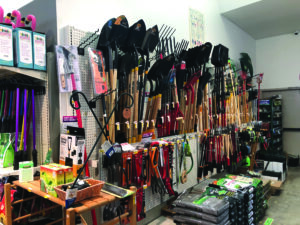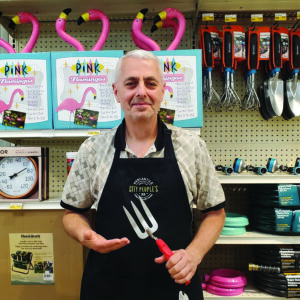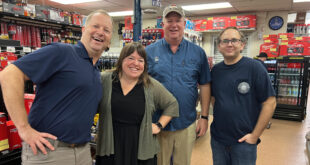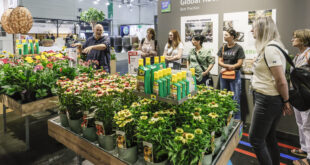When it comes to your operation’s lawn and garden department, a small space doesn’t have to equal small sales. With over 36 years of lawn and garden product purchasing experience, Mike Doyle, lawn and garden buyer for City People’s Mercantile, has plenty of experience making use of the limited selling space available in the Seattle store. He shares his merchandising and customer service best practices and how to maximize selling space in a small store.
Grow a Category With Limited Space
Located in an urban area, the City People’s Mercantile store is small—10,000 square feet—with limited selling space. Doyle says lawn and garden products are cross merchandised in a lot of different departments of the store, making it hard to say exactly how much selling space the section entails. He estimates the main area of his lawn and garden section is about 500 square feet.
The lawn and garden section includes hardline lawn and garden products like fertilizers, watering supplies, tools, gloves, wild bird supplies and lawn seed. Doyle also purchases the products for a 600-square-foot area outside that displays pallets of potting soil, soil amendments and mulch. Other buyers are in charge of purchasing for the garden center, which features pottery and live plants.
 City People’s Mercantile is located in an affluent neighborhood with many older community members who enjoy gardening. These customers’ gardening needs have led to Doyle specializing in high-quality gloves and garden tool products.
City People’s Mercantile is located in an affluent neighborhood with many older community members who enjoy gardening. These customers’ gardening needs have led to Doyle specializing in high-quality gloves and garden tool products.
“When I started working at City People’s Mercantile in 2000, the garden tool section was a 25-foot poorly organized wall display,” Doyle says. “After I reset and reordered the area, I gained about 4 feet of additional selling space.”
From there, Doyle began paying attention to what did and didn’t sell—something he now tries to do at least yearly and more frequently when he can.
“If I want to add a product to a section, I have to get rid of a product already there unless I have a good reason to expand the section,” Doyle says. “For instance, we sell a lot of rakes, so I expanded that section and decreased the amount of garden hoses due to low sales.”
This practice ensures a shrewd use of limited space and limits the presence of slow-moving merchandise.
“I was always told to buy what I like and if that sells, that’s great. If not, buy what customers like and learn to love it,” Doyle says. “Listening to customers, knowing what they want and stocking for their needs are the keys to success. If you don’t sell a highly requested product, you should have a really good reason why you don’t.”
Make the Most of Merchandising
In small spaces, hanging lawn and garden products randomly on pegs can lead to inefficient use of the space and unhappy customers.
“Human minds like order, and when merchandising is chaotic, customers have a more difficult and unpleasant shopping experience,” Doyle says. “Messes can quickly get out of hand in a small sp ace; keeping everything organized will create a sense of ease and invite customers in.”
ace; keeping everything organized will create a sense of ease and invite customers in.”
For example, shovels should be hanging by their blade in a row close to customers’ eye lines so they don’t have to look down and can easily compare products, Doyle says. Bags full of materials like sand and fertilizer should be neatly stacked. When similar products are merchandised together, customers have an easier time finding and choosing what they need without getting lost or overwhelmed, Doyle says. He takes this approach to all of his displays but keeps this strategy in mind specifically when building endcaps.
“Endcaps should be simple, have a theme, change with the seasons and feature four to six SKUs,” Doyle says. “You want displays to be simple enough for customers to understand what project you’re selling but complex enough to make them feel like they have options.”
When choosing the timing for changing endcaps or attention-grabbing displays, Doyle suggests early adjustments.
“If your customers need watering cans in July, set up the display in June so they see it, remember it and return to make the purchase when they need it,” Doyle says.
Rooted in Customer Service
When initially greeting customers, Doyle focuses on creating a positive interaction.
 “Instead of asking ‘Can I help you,’ I say ‘If there is anything I can help with, let me know’ or ‘Are you finding everything okay?’” Doyle says. “This phrasing leads to more positive responses and customer experiences. I try to never ask a question where ‘No’ will be the answer.”
“Instead of asking ‘Can I help you,’ I say ‘If there is anything I can help with, let me know’ or ‘Are you finding everything okay?’” Doyle says. “This phrasing leads to more positive responses and customer experiences. I try to never ask a question where ‘No’ will be the answer.”
City People’s Mercantile stocks high-quality products, and customers sometimes balk at the higher prices, but Doyle has strategies to put their purchase in perspective.
“Sometimes I’ll share my personal experience with the product and highlight that it’s long-lasting. For soils and composts, I’ll also tell them that if they are unhappy with it they can bring it back and I’ll buy it back from them, or I’ll compare the price to how many cups of coffee it would be,” Doyle says.
Like in many other operations, technology has impacted how customers shop and customer service at City People’s Mercantile. Customers think they can find all the right answers on the internet, but it is too easy for them to find a bad source, not understand something or miss a step when consulting the web, Doyle says.
“Despite this reality, I strive to never tell a customer they are doing something wrong. Instead, I share options I would choose over their current strategy,” he says. “There’s a million ways to garden and none of them are wrong, some just might work a little better.”
7 Trendy Lawn and Garden Products Not to Leaf Behind
Discover what products Doyle says have become popular at City People’s Mercantile.
- Lightweight fabric garden hoses
- Thumb-control watering nozzles
- Organic fertilizers and pesticides
- Rabbit repellents and fencing
- Quick-connect hose fittings
- Wild bird seed and supplies
- Large bags of potting soil, compost and bark mulch
 Hardware Retailing The Industry's Source for Insights and Information
Hardware Retailing The Industry's Source for Insights and Information








